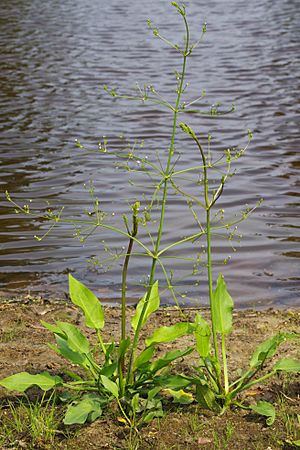Alismatales facts for kids
Quick facts for kids Alismatales |
|
|---|---|
 |
|
| Alisma plantago-aquatica | |
| Scientific classification | |
| Kingdom: | |
| Division: | |
| Class: | |
| Order: |
Alismatales
|
| Families | |
|
See text |
|
The Alismatales are a special group of flowering plants. They are known for living in marshy and aquatic (water) habitats. This plant group includes 14 different families of plants. Many plants in this group grow completely underwater or in very wet soil.
Contents
What are Alismatales?
Alismatales are an "order" of plants. In biology, an order is a way to group living things that are related. All plants in the Alismatales order share common features. A big one is that they are monocots.
Monocots Explained
Monocots are one of the two main groups of flowering plants. The word "monocot" means "one seed leaf." This refers to how the plant sprouts from its seed.
- Monocots have one cotyledon (seed leaf) when they first grow.
- Their leaves usually have veins that run parallel to each other.
- Their flower parts often come in groups of three.
- Grasses, lilies, and orchids are other examples of monocots.
Where Do Alismatales Live?
Plants in the Alismatales order are found all over the world. They prefer wet places. You can find them in many different watery environments:
- Freshwater: This includes ponds, lakes, rivers, and streams. Many water lilies and pondweeds live here.
- Marshes and Swamps: These are wetlands with very wet soil. Some Alismatales grow partly in water and partly in air.
- Saltwater: Some families, like the Zosteraceae, are true seagrasses. They live completely submerged in the ocean. These plants are very important for marine life.
Families of Alismatales
The Alismatales order includes 14 different plant families. Each family has its own unique types of plants. Here are some of the main families:
- Alismataceae: This family includes water plantains and arrowhead plants. They often have broad leaves and small flowers.
- Aponogetonaceae: These are mostly aquatic plants found in tropical and subtropical regions. They are known for their interesting flower spikes.
- Araceae: This large family includes plants like arum lilies and taro. Many have a special flower structure called a spathe and spadix. Some are also popular houseplants.
- Hydrocharitaceae: This family is made up of submerged or floating aquatic plants. Examples include frogbit and waterweeds. Many are important for underwater ecosystems.
- Potamogetonaceae: These are commonly known as pondweeds. They are found in freshwater habitats worldwide. They often have long, thin leaves.
- Zosteraceae: This family contains seagrasses. These are true flowering plants that live in the ocean. They form important underwater meadows.
These families show how diverse the Alismatales order is. From tiny floating plants to large seagrass beds, they all share a love for water.
Importance of Alismatales
Alismatales plants play a very important role in their ecosystems.
- Food Source: Many aquatic animals, like fish, ducks, and insects, eat these plants.
- Habitat and Shelter: Dense beds of these plants provide safe places for fish to lay eggs. They also offer shelter for young aquatic animals.
- Water Quality: Some aquatic plants help filter water. They can absorb extra nutrients, which helps keep the water clean.
- Oxygen Production: Like all green plants, Alismatales produce oxygen through photosynthesis. This oxygen is vital for aquatic life.
- Preventing Erosion: Their roots help hold soil in place along shorelines. This stops the soil from washing away.
These plants are a key part of healthy wetland and aquatic environments.
Images for kids
-
Ottelia alismoides from family Hydrocharitaceae in Hyderabad, India.
See also
 In Spanish: Alismatales para niños
In Spanish: Alismatales para niños



